Strong, washboard abs. They’re on many people’s wish lists. But there’s more to a tight stomach than just vanity.
Athletes in particular rely on abdominal strength to excel in their sports.
Exercise science majors Rachel Britton and Marysa Meyer teamed up to see if abdominal strength plays a role in figure skaters’ ability to complete jump rotations.
“We know from our own experience that in figure skating, maintaining a strong core is key for holding one’s position while rotating midair in a jump or in a spin,” Rachel Britton explained.
For their 300-level biomechanics course, Britton and Meyer, who have been figure skating since they were in kindergarten, tested between 15 and 20 regional figure skaters ages 18 and older. The mix was comprised of “a jumble of athletes,” Meyer said, including members of the University of Minnesota hockey cheer squad and one 18-year-old elite skater from Britton’s home rink in Rochester, Minn.
Subjects voluntarily submitted recordings of themselves completing the most difficult jump they were able to land. Most fell into the single- and double-rotation range. Britton and Meyer then reviewed the footage to confirm the number of rotations each skater was able to complete.
There are six styles of jumps that ascend in difficulty: salchow, toe loop, loop, flip, lutz and axel. Axels are the highest of jumps in figure skating and the only jump in which the skater takes off forward. (Fun fact: Japan’s Midori Ito broke ground in women’s figure skating when she became the first female to land the prized triple axel in both professional competition in 1988 and at the Olympic games in 1992, earning the 4-foot-10-inch skater the nickname “the jumping flea.”)
The Rochester figure skater was the only subject in their study who could complete a triple jump (loop, toe loop and salchow). The pair admitted their greatest research challenge was tracking down skaters who could complete more than a single rotation.
“Most skaters are only able to complete single or double jumps; those who can land triple jumps are often at the elite or professional level. And very few elite competitors are able to land quadruple jumps,” Britton said.
To test for abdominal strength, they used what’s called a Layfayette manual muscle tester – a hand-held tool that measures the force a muscle exerts. They pressed the tool to each subject’s outer left and right clavicles to test left and right oblique (side abdominals) strength and one on the chest to test rectus abdominis strength (the washboard muscle). Then they asked subjects to lift and hold a basic crunch while they measured the subjects' highest level of resistance.
What they were looking for was not how many sit-ups a subject could complete but “the highest level of opposition” the subject was able to resist while attempting a crunch, Meyer explained. “Maximum sit-ups measures endurance and that’s not what we were looking for,” she said.
The end result? “We were surprised that we did not find a correlation between abdominal strength and number of jump rotations a skater could complete,” Britton said. Both she and Meyer acknowledged that their sample size was a determining factor. She also noted that recreational figure skaters, in her experience, tend not to focus on core conditioning.
She added, “We knew it would be difficult to get conclusive results if we weren’t able to recruit enough skaters from each (single, double and triple jumpers) ability level.”
However, they also employed vertical jump height tests to gauge if there was a correlation between vertical jump height and whether a skater could complete a single or double jump. Unlike the abdominal strength tests, the jump-height results showed a correlation, though it was minimal.
"We tested for a correlation using a Pearson product-moment correlation test (a measure of the linear dependence between two variables) on Minitab 16 (statistical software used for analyzing data) between three groups of data: single vs. double jumpers, double vs. double-axel jumpers, and double-axel jumpers vs. single jumpers. No significant correlations were found for the latter groups, but a slight correlation was indicated among the single vs. double jumpers," Britton said.
Though their study didn’t reveal significant results, Meyer said, “Our field is so hands on, so it’s important to get experience with all the technology our department is investing in. It’s really helpful in the learning process."
Both Britton and Meyer will pursue advanced degrees in physical therapy after they graduate this spring.







